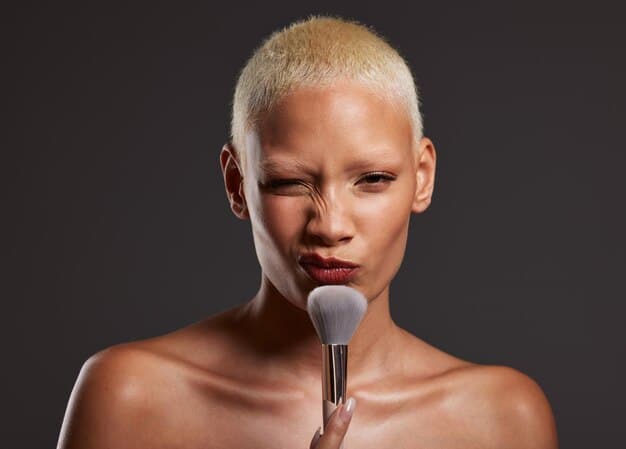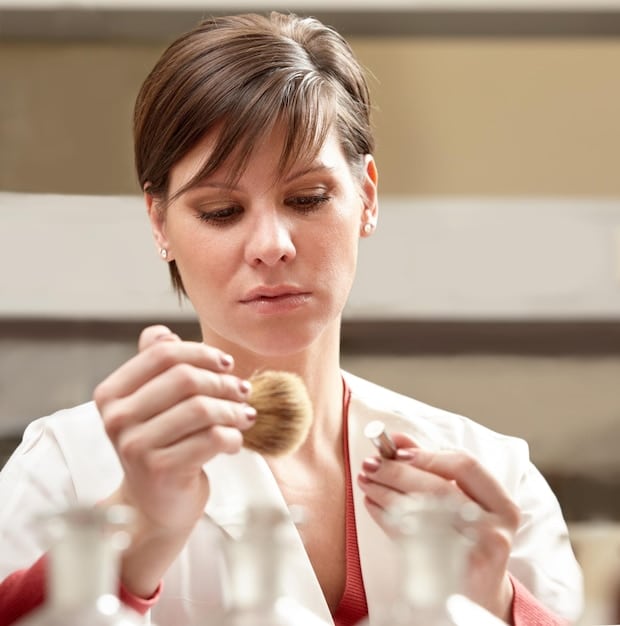Contour Like a Pro: Your 2025 Guide to Face Sculpting

Advertisements
Contouring, a makeup technique used to sculpt and define facial features, is evolving, and this step-by-step guide will help you master the art of contouring like a pro in 2025, ensuring a flawless and sculpted look.
Ready to elevate your makeup game and contour like a pro: a step-by-step guide for sculpting your face in 2025? This guide will take you through everything you need to know, from choosing the right products to mastering the blending techniques that will leave you looking effortlessly sculpted.
Advertisements
Understanding Contour: The Basics for 2025
Contouring is more than just applying dark makeup; it’s about understanding light and shadow to enhance your natural features. In 2025, the trends lean towards a more natural, seamless finish, focusing on enhancing rather than masking your face shape.
What is Contouring?
Contouring involves using a product that is darker than your skin tone to create shadows in areas you want to define. This technique helps to sculpt your face, making features like cheekbones appear higher and sharper, and your jawline more defined.
Advertisements
The Evolution of Contouring
Over the years, contouring has evolved from heavy, Instagram-ready looks to softer, more subtle enhancements. The key in 2025 is to embrace a natural finish that complements your overall makeup, rather than overpowering it.
- Skin Prep is Key: Start with a well-moisturized base.
- Choose the Right Shade: Opt for a contour shade that is 2-3 shades darker than your skin tone.
- Blend, Blend, Blend: Seamless blending is crucial for a natural look.
By understanding these basics, you’ll be well-equipped to start your contouring journey with confidence. The goal is to enhance your natural beauty, not to create a completely new face.
Choosing the Right Contour Products for Your Skin Tone
Selecting the right contour product is essential for achieving a natural, sculpted look. The ideal product will depend on your skin tone, skin type, and personal preference. In 2025, there are more options than ever before, ranging from powders to creams and liquids.
Powder Contours
Powder contours are great for those with oily or combination skin, as they tend to have a mattifying effect. They’re also buildable, making them easier to control and perfect for beginners.
Cream Contours
Cream contours are ideal for dry or mature skin, providing a hydrating finish that blends seamlessly into the skin. They offer a more natural look and can be easily blended with a beauty sponge or your fingers.
- Fair Skin: Opt for cool-toned taupe shades.
- Medium Skin: Choose a neutral brown shade.
- Deep Skin: Select a deep, warm brown or even a shade with red undertones.
Ultimately, the best contour product is the one that works best for your skin type and personal style. Experiment with different formulations to find what gives you the most natural and sculpted look.
Step-by-Step: Applying Contour Like a Pro
Now that you understand the basics and have your products ready, it’s time to dive into the step-by-step process of applying contour like a pro. This technique involves strategic placement of product and meticulous blending to create the illusion of depth and dimension.
Step 1: Prep Your Skin
Start with a clean, moisturized face. Apply your foundation and concealer as you normally would. This creates a smooth canvas for your contour.
Step 2: Apply Contour
Using a contour brush, apply the product to the hollows of your cheeks, starting from your ear and blending towards the corner of your mouth. Also, apply contour along your temples, jawline, and the sides of your nose.
- Cheekbones: Suck in your cheeks to find the hollows and apply contour in this area.
- Jawline: Apply contour along your jawline to define your face and create a more sculpted look.
- Nose: Apply thin lines of contour along the sides of your nose to make it appear slimmer.
Pay attention to your face shape and adjust the placement accordingly. The goal is to enhance your natural features and create balance.
The Art of Blending: Achieving a Seamless Finish
Blending is the key to a natural-looking contour. Without proper blending, your contour can look harsh and unnatural. Using the right tools and techniques can make all the difference.
Using a Beauty Sponge
A damp beauty sponge is excellent for blending cream and liquid contours. The dampness helps to sheer out the product and create a seamless finish.
Using a Contour Brush
A fluffy contour brush is perfect for blending powder contours. Use circular motions to buff the product into your skin, ensuring there are no harsh lines.
- Start Light: Begin with a small amount of product and build up as needed.
- Use Circular Motions: Blend the product in circular motions to avoid streaks.
- Check in Natural Light: Step away from the mirror and check your contour in natural light to ensure it looks natural.
Blending is an essential skill to master. With practice, you’ll develop a feel for how much product to use and how to blend it for the most natural effect.

Highlighting: The Perfect Complement to Contouring
Highlighting and contouring go hand in hand. While contouring creates shadows, highlighting illuminates and brings forward certain features. Together, they create a balanced and sculpted look.
Choosing the Right Highlighter
The right highlighter will depend on your skin tone and the look you want to achieve. For a natural glow, opt for a subtle, illuminating highlighter. For a more dramatic look, choose a shimmer or glitter highlighter.
Applying Highlighter
Apply highlighter to the high points of your face, such as your cheekbones, brow bone, the bridge of your nose, and your cupid’s bow. This will catch the light and enhance your features.
- Powder Highlighter: Use a tapered brush for precise application.
- Cream Highlighter: Use your fingertips or a small sponge for seamless blending.
- Less is More: Start with a small amount of product and build up as needed.
By mastering the art of highlighting, you can take your contouring to the next level. The contrast between light and shadow will create a more defined and sculpted look.
Contouring for Different Face Shapes
Not all contouring techniques are created equal. The best approach for contouring depends on your face shape. Understanding your face shape and tailoring your contour accordingly is essential for achieving the most flattering results.
Round Face
For a round face, focus on adding length and definition. Apply contour along the sides of your face, from your temples to your jawline.
Square Face
For a square face, soften the angles by applying contour to your forehead and jawline.

- Oval Face: Apply contour to the hollows of your cheeks, temples, and jawline to enhance your natural features.
- Heart-Shaped Face: Apply contour to your forehead and chin to balance your features.
- Diamond Face: Apply contour to your cheekbones to soften the angles of your face.
By considering your face shape, you can customize your contouring to accentuate your best features and achieve a balanced, harmonious look. Experiment with different techniques and find what works best for you.
Common Contouring Mistakes to Avoid
Even with the best products and techniques, it’s easy to make mistakes when contouring. Knowing these common pitfalls and how to avoid them can help you achieve a flawless finish every time.
Using the Wrong Shade
Using a contour shade that is too warm or too dark can make your contour look muddy and unnatural. Always opt for a cool-toned shade that is 2-3 shades darker than your skin tone.
Applying Too Much Product
Applying too much contour product can result in harsh lines and an overall unnatural look. Start with a small amount of product and build up as needed.
- Poor Blending: Not blending your contour properly can leave harsh lines visible.
- Ignoring Your Face Shape: Applying contour without considering your face shape can result in unflattering results.
- Using the Wrong Tools: Using the wrong brushes or sponges can make blending difficult and uneven.
By avoiding these common mistakes, you can ensure that your contour looks natural and enhances your features. Practice makes perfect, so don’t be afraid to experiment and learn from your errors.
| Key Point | Brief Description |
|---|---|
| 🎨 Choosing Products | Select products based on your skin tone and type for a natural look. |
| 🖌️ Application | Apply contour to cheek hollows, jawline, and temples for definition. |
| 🧽 Blending | Blend seamlessly with a beauty sponge or brush for a natural finish. |
| ✨ Highlighting | Highlight the high points of your face to complement the contour and add dimension. |
FAQ: Mastering Contour Like a Pro
▼
For fair skin, opt for cool-toned taupe shades. These shades mimic natural shadows without appearing too harsh. Avoid warm or orange-toned contour shades, as they can look unnatural on fair skin.
▼
Use a damp beauty sponge to blend cream contour effectively. Gently dab and roll the sponge over the product to sheer it out and create a seamless finish. Avoid dragging the sponge, as this can move the product and create streaks.
▼
Bronzer can be used as contour if it has a matte finish and is only slightly warmer than your skin tone. However, true contour shades are usually cooler and create more natural shadows. It depends on the specific product and desired effect.
▼
Apply highlighter to the high points of your face, such as the cheekbones, brow bone, bridge of your nose, and cupid’s bow. These areas naturally catch the light and will enhance your features when highlighted.
▼
Clean your contour brushes at least once a week to prevent product buildup and bacteria growth. This will ensure that your makeup applies smoothly and that your skin stays healthy. Use a gentle brush cleanser or soap and water.
Conclusion
Mastering the art of contouring is within your reach. By understanding the basics, choosing the right products, and practicing your blending techniques, you can achieve a sculpted and defined look that enhances your natural beauty. Embrace the 2025 trends and create a contour that is both subtle and stunning.